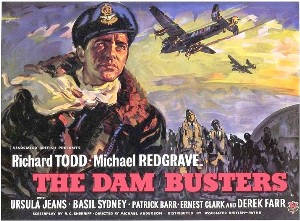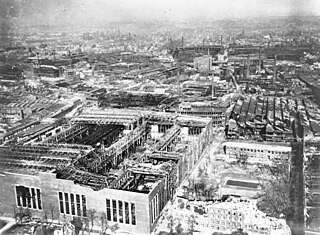
The Avro Lancaster, commonly known as the Lancaster Bomber, is a British Second World War heavy bomber. It was designed and manufactured by Avro as a contemporary of the Handley Page Halifax, both bombers having been developed to the same specification, as well as the Short Stirling, all three aircraft being four-engined heavy bombers adopted by the Royal Air Force (RAF) during the same era.

The Dam Busters is a 1955 British epic docudrama war film starring Richard Todd and Michael Redgrave, that was directed by Michael Anderson. Adapted by R. C. Sherriff from the books The Dam Busters (1951) by Paul Brickhill and Enemy Coast Ahead (1946) by Guy Gibson, the film depicts the true story of Operation Chastise when in 1943 the RAF's 617 Squadron attacked the Möhne, Eder, and Sorpe dams in Nazi Germany with Barnes Wallis's bouncing bomb.

Sir Barnes Neville Wallis was an English engineer and inventor. He is best known for inventing the bouncing bomb used by the Royal Air Force in Operation Chastise to attack the dams of the Ruhr Valley during World War II.

Operation Chastise, commonly known as the Dambusters Raid, was an attack on German dams carried out on the night of 16/17 May 1943 by 617 Squadron RAF Bomber Command, later called the Dam Busters, using special "bouncing bombs" developed by Barnes Wallis. The Möhne and Edersee dams were breached, causing catastrophic flooding of the Ruhr valley and of villages in the Eder valley; the Sorpe Dam sustained only minor damage. Two hydroelectric power stations were destroyed and several more damaged. Factories and mines were also damaged and destroyed. An estimated 1,600 civilians – about 600 Germans and 1,000 enslaved labourers, mainly Soviet – were killed by the flooding. Despite rapid repairs by the Germans, production did not return to normal until September. The RAF lost 56 aircrew, with 53 dead and 3 captured, amid losses of 8 aircraft.

The Douglas C-54 Skymaster is a four-engined transport aircraft used by the United States Army Air Forces in World War II and the Korean War. Like the Douglas C-47 Skytrain derived from the DC-3, the C-54 Skymaster was derived from a civilian airliner, the Douglas DC-4. Besides transport of cargo, the C-54 also carried presidents, prime ministers, and military staff. Dozens of variants of the C-54 were employed in a wide variety of non-combat roles such as air-sea rescue, scientific and military research, and missile tracking and recovery. During the Berlin Airlift it hauled coal and food supplies to West Berlin. After the Korean War it continued to be used for military and civilian uses by more than 30 countries. It was one of the first aircraft to carry the President of the United States, the first being President Franklin D. Roosevelt during World War II.

A bouncing bomb is a bomb designed to bounce to a target across water in a calculated manner to avoid obstacles such as torpedo nets, and to allow both the bomb's speed on arrival at the target and the timing of its detonation to be predetermined, in a similar fashion to a regular naval depth charge. The inventor of the first such bomb was the British engineer Barnes Wallis, whose "Upkeep" bouncing bomb was used in the RAF's Operation Chastise of May 1943 to bounce into German dams and explode underwater, with an effect similar to the underground detonation of the later Grand Slam and Tallboy earthquake bombs, both of which he also invented.

Tallboy or Bomb, Medium Capacity, 12,000 lb was an earthquake bomb developed by the British aeronautical engineer Barnes Wallis and used by the Royal Air Force (RAF) during the Second World War.

Eastern Provincial Airways (EPA) was an airline that operated in Atlantic and eastern Canada. At its peak, the carrier operated jet service with Boeing 737-200 aircraft connecting many communities that today only have scheduled passenger flights provided by 18-seat commuter turboprop aircraft. The airline traces its history from Maritime Central Airways (MCA) from 1961. It merged with CP Air to form Canadian Pacific Air Lines in 1986.

The Möhne Reservoir, or Moehne Reservoir, is an artificial lake in North Rhine-Westphalia, some 45 km east of Dortmund, Germany. The lake is formed by the damming of two rivers, Möhne and Heve, and with its four basins stores as much as 135 million cubic metres of water.

Buffalo Airways is a family-run airline based in Yellowknife, Northwest Territories, Canada, established in 1970. Buffalo Airways was launched by Bob Gauchie and later sold to one of his pilots, Joe McBryan. It operates charter passenger, charter cargo, firefighting, and fuel services, and formerly operated scheduled passenger service. Its main base is at Yellowknife Airport. It has two other bases at Hay River/Merlyn Carter Airport and Red Deer Regional Airport. The Red Deer base is the main storage and maintenance facility. The airline is also the subject of the History television reality series Ice Pilots NWT.

The British "Victory Bomber" was a Second World War design proposal by British inventor and aircraft designer Barnes Wallis while at Vickers-Armstrongs for a large strategic bomber. This aircraft was to have performed what Wallis referred to as "anti-civil engineering" bombing missions and was to have carried his projected 22,000 lb (10,000 kg) "earthquake bomb" to strategic targets in Nazi Germany. The Victory Bomber was considered extremely ambitious: the Royal Air Force (RAF) at that time not yet having introduced four-engine heavy bombers, to give the necessary performance, the Victory Bomber was to have six engines and was highly specialised to its role.
The tsunami bomb was an attempt during World War II to develop a tectonic weapon that could create destructive tsunamis. The project commenced after United States Navy officer E.A. Gibson noticed small waves generated by explosions used to clear coral reefs. The idea was developed by the United States and New Zealand military in a program code named Project Seal. The weapons concept was deemed feasible, but the weapons themselves were never fully developed or used. A related concept, the bouncing bomb was developed and used in World War II, to be dropped into water as a means to destroy German dams and cause loss of industrial capacity and widespread flooding.

The Sorpe Dam is a dam on the Sorpe river, near the small town of Sundern in the district of Hochsauerland in North Rhine-Westphalia, Germany.

The Battle of the Ruhr was a strategic bombing campaign against the Ruhr Area in Nazi Germany carried out by RAF Bomber Command during the Second World War. The Ruhr was the main centre of German heavy industry with coke plants, steelworks, armaments factories and ten synthetic oil plants. The British attacked 26 targets identified in the Combined Bomber Offensive. Targets included the Krupp armament works (Essen), the Nordstern synthetic oil plant at Gelsenkirchen and the Rheinmetall–Borsig plant in Düsseldorf, which was evacuated during the battle. The battle included cities such as Cologne not in the Ruhr proper but which were in the larger Rhine-Ruhr region and considered part of the Ruhr industrial complex. Some targets were not sites of heavy industry but part of the production and movement of materiel.

The Hamilton H-45 and H-47 were six-passenger-seat, all-metal, high-wing monoplanes powered by single Pratt & Whitney radial engines. They were built for passenger and mail-carrying work in the US in the late 1920s.

David John Shannon, DSO & Bar, DFC & Bar was an Australian bomber pilot of World War II, known for his part in the "Dambusters" raid on the night of 16/17 May 1943. Born in South Australia, Shannon joined the Royal Australian Air Force (RAAF) in 1941 and learned to fly under the Empire Air Training Scheme. After further training in the United Kingdom he was posted to No. 106 Squadron RAF, operating Avro Lancaster heavy bombers, and was awarded the Distinguished Flying Cross (DFC) in January 1943.

Joseph Charles "Big Joe" McCarthy, was an American aviator who served with the Royal Canadian Air Force in Bomber Command during World War II. He is best known as the commander and pilot of Lancaster AJ-T ("T-Tommy") in Operation Chastise, the "Dambuster" raid of 1943.

Squadron Leader David John Hatfeild Maltby, was a bomber pilot in the Royal Air Force, best known for his part as the pilot of Lancaster AJ-J (“Johnny”) in the Dambusters raid. He had successfully completed over 30 operations before his death in September 1943.

John Vere Hopgood, was a pilot with No. 617 Squadron of the Royal Air Force (RAF). He was killed in action while taking part in Operation Chastise, popularly known as the 'Dam Busters' raid.

















